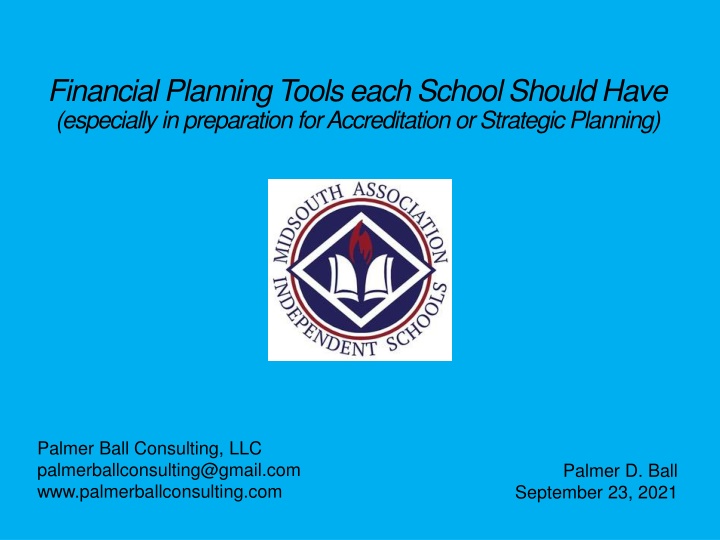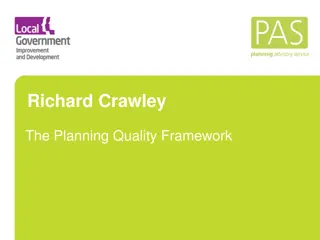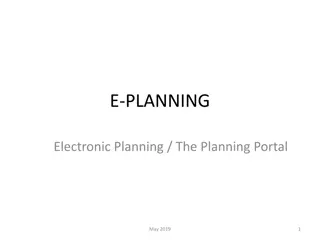
Essential Financial Planning Tools for School Accreditation and Strategic Planning
Enhance financial planning and analysis in schools with crucial tools for accreditation and strategic planning. Recommendations include data analysis, financial modeling, and benchmarking to drive informed decision-making.
Download Presentation

Please find below an Image/Link to download the presentation.
The content on the website is provided AS IS for your information and personal use only. It may not be sold, licensed, or shared on other websites without obtaining consent from the author. If you encounter any issues during the download, it is possible that the publisher has removed the file from their server.
You are allowed to download the files provided on this website for personal or commercial use, subject to the condition that they are used lawfully. All files are the property of their respective owners.
The content on the website is provided AS IS for your information and personal use only. It may not be sold, licensed, or shared on other websites without obtaining consent from the author.
E N D
Presentation Transcript
Financial Planning Tools each School Should Have (especially in preparation for Accreditation or Strategic Planning) Palmer Ball Consulting, LLC palmerballconsulting@gmail.com www.palmerballconsulting.com Palmer D. Ball September 23, 2021
Opening Disclaimers I am not addressing fiduciary compliance of the board related to a number of financial matters typically addressed during the accreditation process (HR, 403(b), FMLA, endowments / UPMIFA, audits, etc.) o I am just addressing financial planning and analysis and things boards, as fiduciaries, should be asking questions about, and thus information the Business Officer should have.
Tools Toolbox each school should have to make data informed decisions Strongly Recommend 5 10 year NAIS DASL (Data Analysis for School Leadership) or NBOA BIIS (Business Intelligence for Independent Schools) trends for the school (NAIS DASL template provided) o For non DASL or BIIS participants, 5 10 year trends of important data points for the school (use NAIS DASL template provided) Observe the trends for each data point and identify the most important trends and the main conclusions that can be obtained from this chart DASL or BIIS comparative data with benchmark schools (template provided) o Local or regional schools oAspirational schools o Suggestion use ratios to normalize size differences with other schools (i.e. endowment per student, benefit costs as a percentage of compensation, etc.)
Tools Toolbox each school should have to make data informed decisions (continued) Strongly Recommend National Business Officers Association (NBOA) s Long Range Financial Model or MISBO s Budget Model (available on their websites to members) 3 5 year financial dashboard (template provided) 14 year financial aid model (template provided) Faculty salary analysis with public schools and benchmark schools (template provided) Cost effectiveness by division and LS class size breakeven (template provided) Net tuition revenue analysis over last 5 years (template provided)
Tools Toolbox each school should have to make data informed decisions (continued) Strongly Recommend - Net tuition revenue comparison by grade and percentage of each class with financial aid (template provided) Recommend - Class Size Model (template provided) Demographic information (free from NAIS or NBOA for your community) Commonfund s HEPI Index to recast tuition Commonfund s CPI Index to recast faculty salaries
Disclaimers / Caveats Once the data has been gathered, it should be reviewed for trends and to identify the story the figures are telling. oWhile some info is likely well known (i.e. enrollment trends), what might not be so obvious is what s causing it (attrition, new student enrollment, etc.). o General observations about faculty salaries, employee headcount, endowment, etc. should jump off the page from reviewing the trends and comparing to benchmark schools. o These observations can then inform the action plans for the strategic plan and accreditation report.
Disclaimers / Caveats (continued) The data doesn t draw conclusions about what might be impacting the trends (i.e. decreasing enrollment might be due to value proposition, perception, quality of faculty, tuition, etc.). o The data simply identifies the trends and leaves it up to the school s leadership to determine the contributing factors and the plan of action to address. o For example, if new student enrollment is declining, the strategic plan might target increasing the number of new students through re-branding, increased marketing, scholarship competitions, etc.
Disclaimers / Caveats (continued) Finally, sample questions to ask are provided this is not an exhaustive list of questions and it does not touch on every subject. This simply shows the types of questions that school leaders should ask to determine opportunities for improvement and inclusion in the strategic plan or accreditation report. Thus, these are questions that Business Officers need to be prepared to answer. oSome regional accreditation standards ask these exact questions, although most standards are more general and not as specific.
Tools should be used to review trends in 4 major areas 1 - Enrollment oEnrollment o Financial Aid o Tuition and Fees 2 Employment oCompensation o FTEs o Class Sizes
Tools should be used to review trends in 4 major areas (continued) 3 Financial oNet Tuition Revenue o NAIS DASL comparative data o Cost effectiveness by division o Tuition Gap (difference between NTR and total expenses) o Future budget projections 4 Miscellaneous oEndowment o Debt o Annual Fund o Dashboard o Physical Plant
2 Major Questions to Ask Where has the school been? o What does the school s recent historical data reveal about what the school has been doing well, or what the school hasn t been doing well? Where is the school going? o What does the school s recent historical data reveal about where the school will be in 5 years if the trends continue? o Can the school focus efforts to turn around the negative trends? o What will happen if the school doesn t turn around the negative trends? o What new actions does the school need to take to get to where they want to be?
1 - Enrollment Enrollment Trends Financial Aid Trends Tuition and Fees Sample questions to answer o Is tuition appropriate? o How does it compare to benchmark schools? o How has it changed over 5 years compared to benchmark schools? o Has it kept up with inflation over the last 5 years? o Use Commonfund HEPI Index figures to recast tuition o What are enrollment trends for o New student enrollment? o Attrition? o International students? o Percentage of student body on financial aid?
1 - Enrollment (continued) Sample tools needed to answer the questions o Change in 12th grade tuition over 5 years compared to benchmark schools 35% 32% 31% 31% 30% 27% 27% 27% 26% 24% 25% 21% 21% 21% 20% 20% 20% 19% 18% 18% 17% 17% 16% 15% 10%
1 - Enrollment (continued) Sample tools needed to answer the questions o 12th grade tuition recast for inflation over 5 years shows tuition has actually declined for the last 2 years 2015-16 2016-17 2017-18 2018-19 2019-20 Recast 12th Grade Tuition (Inflation Adjusted Percentage Change - HEPI Index) 31,834 31,861 32,051 31,704 31,662 Annual Change 27 190 (347) (42)
1 - Enrollment (continued) Sample tools needed to answer the questions o DASL 5 10 year trends Sample School DASL Survey for 2020-21 Comparison of Statistical Information Reported Annually for Sample School Percentage Change Since 2016-17 2016-17 2017-18 2018-19 2019-20 2020-21 Enrollment Analysis Prior Year Opening Enrollment Students Added During Prior Year Prior Year Graduating Students Students Who Left During Prior Year or Not Invited to Return Students who Elected Not to Return New Student Enrollment Opening Day Enrollment 673 11 -72 693 691 662 638 -5.20% -27.27% -4.17% 7 6 7 8 -66 -61 -69 -69 -10 -52 143 693 - 8.6% -12 -67 136 691 - 10.8% -35 -48 109 662 - 8.0% -25 -50 113 638 - 8.7% -25 -26 114 640 - 4.7% 150.00% -50.00% -20.28% -7.65% Attrition Percentage -45.47% New Students as a Percentage of Total Enrollment 20.6% 19.7% 16.5% 17.7% 17.8% -13.68%
1 - Enrollment (continued) Sample questions to answer (continued) o How is tuition projected to change over the next 5 10 years? o Can the school s families afford the tuition in 5 10 years? o How are demographics in the community expected to change in 5 10 years? o How much will the tuition gaps between divisions or grades widen over 5 10 years? o Enough to become exit points? o Does the tuition structure need to be reviewed to verify it remains appropriate? Should the school consider one tuition rate for each division? A different tuition rate for each grade? The same tuition rate for each grade? Indexed tuition?
1 - Enrollment (continued) Sample tools needed to answer the questions o NBOA Long Range Financial Model 10 Year Tuition Projections Annual Tuition Increase 5.00% 2020-21 2021-22 2022-23 2023-24 2024-25 2025-26 2026-27 2027-28 2028-29 2029-30 2030-31 Current Yr Year 1 Year 2 Year 3 Year 4 Year 5 Year 6 Year 7 Year 8 Year 9 Year 10 Prekindergarten 14,300 15,020 15,770 16,560 17,390 18,260 19,170 20,130 21,140 22,200 23,310 Kindergarten 17,100 17,960 18,860 19,800 20,790 21,830 22,920 24,070 25,270 26,530 27,860 Grades 1 - 3 19,900 20,900 21,950 23,050 24,200 25,410 26,680 28,010 29,410 30,880 32,420 Grade 4 21,400 22,470 23,590 24,770 26,010 27,310 28,680 30,110 31,620 33,200 34,860 Grades 5 - 8 22,100 23,210 24,370 25,590 26,870 28,210 29,620 31,100 32,660 34,290 36,000 Grades 9 - 12 23,530 24,710 25,950 27,250 28,610 30,040 31,540 33,120 34,780 36,520 38,350
1 - Enrollment (continued) Sample questions to answer (continued) o Is financial aid appropriate? o How does it compare to benchmark schools? o How has it changed over 5 years as compared to the benchmark schools? o Is financial aid growth mission driven or an effort to increase enrollment? o Does your school consider financial aid to be an expense or a revenue generator? o Is financial aid funded or a tuition discount? The following questions relate to tuition discounting used to increase enrollment o How is financial aid expected to change over the next 5 10 years? o How is the percentage of full pay students expected to change over the next 5 10 years? o How will that impact Annual Giving, Capital Campaign giving, parent participation in the school, etc.? o Has there been a change in grades / divisions receiving aid? o For example, years ago, none in Lower School - now 30%.
1 - Enrollment (continued) Sample tools needed to answer the questions o 14 Year Financial Aid Model
1 - Enrollment (continued) Sample questions to answer (continued) oWhat percentage of new students are on financial aid? What is the trend over the last 5 years how has that percentage changed? o How about by division? Is any division getting more new students on aid than other divisions? o What percentage of departing students are on financial aid? What is the trend over the last 5 years - how has that percentage changed? o If the percentage is increasing each year, does this mean that financial aid students are just being bought for a few years, which negatively impacts attrition?
1 - Enrollment (continued) Sample questions to answer (continued) o How does the % of gross tuition revenue spent on financial aid compare to benchmark schools? o How does it compare to NAIS average of 20 22%? (NAIS average includes Tuition Remission so you need to include TR in your calculation) o What is the average award as a percentage of tuition and how has that changed over 5 years? o What percentage of each grade is on financial aid? Are there any grades that are effectively running entire sections of nothing but financial aid students? Are those sections generating enough revenue to cover the cost of the section?
1 Enrollment (continued) Sample questions to answer o On average, what percentage of tuition do financial aid recipients pay and what percentage of tuition do financial aid recipients receive? o Our goal was to collect, on average, more tuition dollars from financial aid recipients, than we gave them o Our goal was to collect 51% and award 49% o How many financial aid recipients are receiving awards that are 76 100% of tuition, and how has that number changed over 5 years? o Ditto for number of recipients for awards that are 0 25% of tuition?
1 - Enrollment (continued) Sample tools needed to answer the questions - o Percentage of each class with Financial Aid 60% 57% 52% 50% 50% 47% 44% 42% 41% 40% 37% 33% 33% 32% 32% 30% 30% 20% 16% 10% 0% 0% 3K 4K 5K 1st 2nd 3rd 4th 5th 6th 7th 8th 9th 10th 11th 12th
2 - Employment Compensation FTEs Class Sizes Sample questions to answer o Are faculty salaries appropriate? o How do they compare to benchmark schools? o Have they kept up with inflation over the last 5 years? o Use Commonfund CPI figures to recast faculty salaries o Are class sizes appropriate? o What is the trend for student / teacher ratios?
2 Employment (continued) Sample tools needed to answer the questions o Recast mean faculty salaries have decreased each of the last 4 years 2015-16 2016-17 2017-18 2018-19 2019-20 Recast Mean Faculty Salary (Inflation Adjusted Percentage Change - CPI Index) 52,497 52,139 50,977 50,909 50,411 Annual Change (359) (1,162) (67) (498) o The mean faculty salary, as adjusted for inflation, is actually $2,000 less than 4 years ago
2 Employment (continued) Sample tools needed to answer the questions o Are class sizes appropriate? Use a class size model to determine parameters for opening new sections.
2 Employment (continued) Sample questions to answer (continued) oHow are faculty salaries in comparison to the school s chief competition, be it the local public schools or local, regional or national independent schools? o How about benefits? Are they competitive? o How have salaries changed over the last 5 years compared to the competition? o Has the school made up ground, stayed even, or lost ground?
2 Employment (continued) Sample tools needed to answer the questions o Salary comparison to public schools Sample School = employees whose salary is 95% or higher of Public School District 2020-21 Salary Information = employees whose salary is 75% or less of Public School District Years of Service Schedule Excess of Percentage of Public Years Total Additional Sample 2020-21 Public School Over Sample School Public At Years of Hours School School Sample Related Degrees Beyond Salaries School Salaries Paid Name School Service Obtained Degree 2020-21 Salary Salaries by Sample Full-Time Faculty - Lower School BS BA BA 8 1Teacher Name 1Teacher Name 1Teacher Name 1Teacher Name 1Teacher Name 1Teacher Name 1Teacher Name 1Teacher Name 26 32 6 16 2 25 7 27 31 32 6 31 4 31 13 32 45,850 37,600 33,100 54,100 32,000 45,600 40,000 48,100 51,770 51,770 37,764 58,537 35,929 62,043 53,543 53,523 5,920 14,170 4,664 4,437 3,929 16,443 13,543 5,423 88.56% 72.63% 87.65% 92.42% 89.06% 73.50% 74.71% 89.87% 15 0 24 0 34 36 48 MED BA MA MA BA
2 Employment (continued) Sample tools needed to answer the questions oDASL comparison with benchmark schools Sample School = positive trend Change in Mean from 2015-16 to 2020-21 = negative trend Sample School Trend in Relation to the Benchmarks 5 Year Change in Mean of Aspirational Schools 5 Year Change in Mean of Regional Schools 5 Year Change in Sample School Mean Faculty Salaries 8.61% 8.61% 3.20% Median Faculty Salaries 8.47% 8.47% 4.17% Starting Faculty Salaries 12.18% 12.18% -5.29% Lowest Faculty Salaries 11.33% 11.33% -5.29% Highest Faculty Salaries 9.18% 9.18% 8.94%
2 Employment (continued) Sample questions to answer (continued) o At the end of the day, despite what the numbers show related to salaries, the overriding questions are o Is the school losing good faculty because salaries or benefits aren t competitive? o Is the school unable to hire the faculty they want because salaries or benefits aren t competitive? o Does the school have an aging faculty and are massive retirements looming? Will younger replacements have a different set of needs (maternity leave, tuition remission, less willingness to coach or go on overnight trips, etc.?)
2 - Employment (continued) Sample questions to answer (continued) o Is employee headcount appropriate? How does it compare to benchmark schools? o How has employee headcount changed over the last 5 years? o Has the change in employee headcount been consistent with the change in student headcount o Has employee headcount increased as the student headcount has increased? o Has employee headcount decreased as the student headcount has decreased? Keep in mind some fixed costs don t change as enrollment changes (i.e. a librarian is needed even if enrollment drops from 650 to 600).
2 - Employment (continued) Sample questions to answer (continued) o Is the change in employee headcount sustainable? o What percentage of the budget comprises salaries and benefits? o For most schools, salaries and benefits are 70 80% of the budget o Likewise, net tuition revenue is typically 70 80% of the budget, thus tuition dollars pay employee costs o How have benefits as a percentage of total compensation changed over the last 5 years? o Is the change sustainable? o If not, what can be done to change it?
3 - Financial Net Tuition Revenue NAIS DASL comparative data Cost effectiveness by division Tuition Gap (difference between NTR and total expenses) Future budget projections Sample questions to answer o How has Net Tuition Revenue per student changed each of the last 5 years? o What percentage of each year s tuition increase did the school actually realize? o Has NTR per student increased each year? o What is NTR per grade?
3 Financial (continued) Sample tools needed to answer the questions o Net Tuition Revenue Analysis Headcount Focus NTR Focus Sample School Net Tuition Revenue Calculation Actual 6/30/19 Actual 6/30/20 Net Tuition Revenue 4,485,101 4,766,527 Increase in Tuition Income Change in Other Tuitions Change in Financial Aid 244,526 -8,970 -183,740 264,375 -19,663 36,714 Increase in Net Tuition Revenue 51,816 281,426 0 0 Percentage Change in Net Tuition Revenue 1.2% 6.3% Percentage of Tuition Increase Realized 22% 115% 9,442 10,229 Net Tuition Revenue per Student Change in Net Tuition Revenue per Student 10 786 Enrollment 475 466 Change in Enrollment Percentage Change in Enrollment 5 (9) 1.1% -1.9%
3 Financial (continued) Sample tools needed to answer the questions oNet Tuition Revenue by Grade Sample School 2020-21 Financial Aid and Net Tuition Revenue by Grade Gross Net Percentag e Percentage Value of Percentage Average Tuition Tuition Number of Number of Value of Grant Per Opening of Class by by Actual Actual Awards of Awards of Awards Awards Award Enrollment With Aid Grade Grade 5th 12 7% 80,000 6,667 37 592,000 512,000 7% 32% 6th 13 70,000 5,385 40 640,000 570,000 8% 6% 33% 7th 11 90,000 8,182 40 640,000 550,000 7% 8% 28% 8th 18 127,500 7,083 40 640,000 512,500 11% 11% 45% Total Middle School 54 32% 367,500 31% 157 34% 2,512,000 2,144,500
3 Financial (continued) Sample questions to answer o How has the cost per division changed over the last 5 years? o Has any division increased its spending per student more significantly than the others? o Why? o How has spending (overall and per student) changed over 5 10 years? o Has its growth outpaced the amount of tuition increases? o How does it compare to benchmark schools? o How has the tuition gap (difference between NTR and total expenses, which is made up through endowment earnings, annual fund donations, auxiliary income, etc.) changed over 5 years? o How has it changed per student? o How does the tuition gap compare to benchmark schools?
3 Financial (continued) Sample tools needed to answer the questions oCost Effectiveness by Division 2013-14 2015-16 2018-19 2019-20 2020-21 Upper School Beginning Enrollment 128 145 143 147 142 Total Expenses 1,454,393 2,514,292 2,529,202 2,721,251 2,720,868 Total Expenses Per Student 11,362 17,340 17,687 18,512 19,161 Net Deficit Per Division (322,476) (691,303) (700,830) (842,796) (814,569) Net Deficit Per Student (2,519) (4,768) (4,901) (5,733) (5,736)
3 Financial (continued) Sample tools needed to answer the questions oCost Effectiveness by Division Lower Middle Upper School School School Total Total Expenses 2,266,214 2,059,827 3,982,430 8,308,471 Total Expenses Per Student 27,637 25,120 25,366 25,883 Net Deficit Per Division (758,329) (80,970) (363,930) (1,203,230) - Net Deficit Per Student (9,248) (987) (2,318) (3,748)
3 Financial (continued) Sample questions to answer o What are the direct operating costs to run a LS classroom? o What is the breakeven number of students needed to cover the direct operating costs of a LS classroom? o How many classes are currently being run at a loss? o Is the school willing to run a loss in order to open up a new section? If so, how much of a loss and thus what is the minimum enrollment to open a new section?
3 Financial (continued) Sample tools needed to answer the questions oClass Size Breakeven Table of Lower School Class Size and Net Loss / Surplus Weighted Cost Number of Average Per Net Loss / Students NTR Section Surplus 5 82,869 146,908 (64,040) 6 99,442 146,908 (47,466) 7 116,016 146,908 (30,892) 8 132,590 146,908 (14,318) 9 149,164 146,908 2,255 10 165,737 146,908 18,829 11 182,311 146,908 35,403 12 198,885 146,908 51,976 13 215,459 146,908 68,550
3 Financial (continued) Sample questions to answer - o What programmatic changes are planned for future years and what impact will they have on tuition? o Can program reductions be made to offset new programs in order to be budget neutral? o If adding Chinese, can Latin or German be dropped? o What are the key variables that need to change over the next 5 10 years for the school to achieve financial equilibrium? How do they need to change? o What will be the outcome of making the changes? o What will happen if the changes are not made?
4 - Miscellaneous Endowment Debt Annual Fund Dashboard Physical Plant Sample questions to answer o What are endowment trends (increasing in value, decreasing in value, earnings exceed withdrawals, etc.)? o Is endowment spending greater or less than earnings?
4 Miscellaneous (continued) Sample tools needed to answer the questions o NBOA Long Range Financial Model - 10 Year Endowment Projections 2019-20 2020-21 2021-22 2022-23 2023-24 2024-25 2025-26 2026-27 2027-28 2028-29 2029-30 Current Yr Year 1 Year 2 Year 3 Year 4 Year 5 Year 6 Year 7 Year 8 Year 9 Year 10 Endowment Income Beginning Endowment Value 8,500,000 8,397,500 8,300,602 8,207,169 8,114,899 8,023,698 7,933,556 7,844,420 7,756,278 7,669,118 7,582,931 Total Return $: 297,500 293,913 290,521 287,251 284,021 280,829 277,674 274,555 271,470 268,419 265,403 Cash Converted to Endowment - - - - - - - - - - - Spending (400,000) (390,811) (383,954) (379,520) (375,223) (370,971) (366,811) (362,697) (358,629) (354,606) (350,583) Ending Endowment Value 8,397,500 8,300,602 8,207,169 8,114,899 8,023,698 7,933,556 7,844,420 7,756,278 7,669,118 7,582,931 7,497,751
4 Miscellaneous (continued) Sample questions to answer (continued) o Is the endowment underwater? If so, how long has it been underwater and when is it projected to be above water? o How do endowment and annual fund totals compare to benchmark schools? o What is endowment per student compared to benchmarks? o What is annual fund participation percentage as compared to benchmarks? o Are debt totals increasing or decreasing? Is there a plan in place to pay debt obligations? o How have debt to endowment ratios changed? o How have debt to annual revenue ratios changed?
4 Miscellaneous (continued) Sample questions to answer (continued) o Does the dashboard show progress in key areas? Are the trends for the majority of the key indicators positive or negative? o What are strengths and weaknesses from a quick glance at the dashboard? o What actions need to be taken to convert negative trends to positive trends?
4 Miscellaneous (continued) Sample tools needed to answer the questions oDashboard Sample School 1 Page Dashboard Summary = positive trend = negative trend = neither positive nor negative trend 2015-16 2016-17 2017-18 Change Net Tuition Revenue 5,069,033 5,026,023 5,384,368 Net Tuition Revenue per Student 11,600 11,826 12,378 Enrollment 437 425 435 Financial Aid 1,070,622 1,260,027 1,346,088 12th Grade Tuition 16,060 16,665 17,325 Attrition % 10.8% 12.3% 6.2% % of Full Pay Students 56.5% 53.4% 54.9% Employee FTEs 78.65 77.95 78.70 Mean Faculty Salaries 45,540 45,178 46,164 Annual Fund (raised prior year) 918,591 909,737 541,346
4 Miscellaneous (continued) Sample questions to answer (continued) o What are the physical plant trends (increasing in value, decreasing in value)? o Are funds being set aside annually for PPRRSM? o How is deferred maintenance expected to change over the next 10 years? o Are building and replacement costs up to date for insurance coverages and calculating pertinent ratios? o Need to update every few years. o Are insurance coverages and deductibles sufficient? Is umbrella policy large enough?
4 Miscellaneous (continued) Sample tools needed to answer the questions o NBOA Long Range Financial Model - 10 Year Physical Plant Projections 2019-20 Current Yr 2020-21 Year 1 2021-22 Year 2 2022-23 Year 3 2023-24 Year 4 2024-25 Year 5 2025-26 Year 6 2026-27 Year 7 2027-28 Year 8 2028-29 Year 9 2029-30 Year 10 Plant Replacement & Renewal Plant Asset Value 3,520,768 2,888,672 2,256,576 1,624,480 992,384 360,288 (271,808) (903,904) (1,536,000) (2,168,096) (2,800,192) Major Construction Projects add: Major Capital Projects Annual Capital Budget Depreciation - - - - - - - - - - - - - - - - - - - - - - (632,096) (632,096) (632,096) (632,096) (632,096) (632,096) (632,096) (632,096) (632,096) (632,096) (632,096) Total Net Plant Expansion (632,096) (632,096) (632,096) (632,096) (632,096) (632,096) (632,096) (632,096) (632,096) (632,096) (632,096) Ending Plant Asset Value 2,888,672 2,256,576 1,624,480 992,384 360,288 (271,808) (903,904) (1,536,000) (2,168,096) (2,800,192) (3,432,288) Starting Deferred Maintenance - 632,096 1,264,192 1,896,288 2,528,384 3,160,480 3,792,576 4,424,672 5,056,768 5,688,864 6,320,960 Renewal & Replacement Target 632,096 632,096 632,096 632,096 632,096 632,096 632,096 632,096 632,096 632,096 632,096 less: purchase of fixed assets less: transfer to PPRRSM - - - - - - - - - - - - - - - - - - - - - - Deferred Maintenance 632,096 1,264,192 1,896,288 2,528,384 3,160,480 3,792,576 4,424,672 5,056,768 5,688,864 6,320,960 6,953,056
Conclusion Thoughts or suggestions for your school? o Will this data be easy to obtain? o Will this data be helpful in analyzing the school s financial status? o Will this data be helpful in preparing for the next strategic plan or accreditation process? o Who at the School will benefit from having this information o Admissions? o Business Office? o Development? o Board Committees? o Marketing Consultants?
The End Any questions?






















